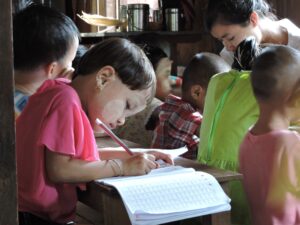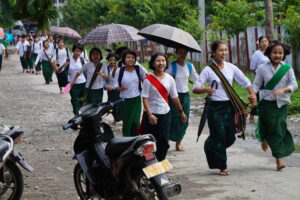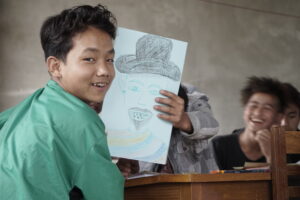Transforming Lives Through Education: Myanmar’s Journey to Empower Street Children
Myanmar grapples with multifaceted challenges, notably in the realm of education. Persistent political unrest, economic hardships, and resource limitations have strained the educational system, resulting in numerous children finding themselves on the streets, exposed to vulnerabilities and dangers. Yet, amidst these challenges, concerted efforts to enhance education in Myanmar offer hope for street children to break the shackles of poverty and forge a better future.
Despite educational reforms since Myanmar’s shift to democracy in 2011, challenges persist. The World Bank reports that, as of 2020, the average Myanmar citizen receives only 7.7 years of schooling, significantly below the regional average (World Bank, 2020). The limited access to education is more pronounced in rural areas, where a vast majority of the population resides.
UNICEF highlights that in 2017, around 1.3 million school-aged children in Myanmar were not attending school, with nearly 50% failing to complete primary education (UNICEF, 2017). This lack of quality education has profound repercussions for both individual lives and the nation’s development.

Street Children in Myanmar: A Crisis Unveiled
The education crisis has forced many children onto the streets, exposing them to physical and mental perils. Street children grapple with malnutrition, lack of shelter, and susceptibility to illnesses. Moreover, they face exploitation through child labour and trafficking as they strive to meet daily needs (Save the Children, 2017).
Beyond physical risks, street children encounter significant mental health challenges. Research by the International Journal of Scientific Research and Management (IJSRM, 2015) reveals emotional and psychological distress, leading to conditions such as depression and anxiety, severely impacting their well-being.
Root Causes of Street Children
Factors such as poverty, limited access to education, and scarce job opportunities contribute to the perpetuation of street children (UNICEF, 2017). Political instability, ethnic conflicts, and natural disasters exacerbate the issue, displacing children and leaving them to navigate the streets alone (Save the Children, 2017).
The Transformative Power of Education

Education emerges as a beacon of hope, capable of breaking the cycle of poverty for street children. By addressing their educational needs, Myanmar can provide opportunities for a brighter future.
- Equipping with Essential Skills: Quality education can arm street children with skills and knowledge, offering better job prospects and reducing vulnerability to exploitation.
- Fostering Social Inclusion: Education empowers by promoting social inclusion and cultivating self-worth, mitigating the psychological distress faced by street children (IJSRM, 2015).
- Tackling Root Causes: Education addresses poverty, fostering social and economic development. A well-educated population contributes to national growth, reducing poverty levels and subsequently decreasing the number of street children (World Bank, 2020).
Path Forward: Improving Education in Myanmar
Efforts to improve education in Myanmar should focus on expanding access to schooling, particularly in rural areas, and enhancing education quality. This can be achieved through increased government funding, partnerships with international organisations, and the involvement of local communities.
Recent positive developments include the introduction of the National Education Strategic Plan (NESP) for 2016-2021 and collaborative efforts by international organisations like UNICEF and Save the Children (UNICEF, 2017). Likewise, Children of the Mekong (COTM) is one of the ways to support street children. Through child sponsorship in providing education and vocational training for substantial and sustainable employment, it can improve their employment prospects as adults with potentially better pay and better working environments. Children will have a higher probability of being able to stay and work in their community to enhance the economy.

In conclusion, education holds the key to a brighter future for street children in Myanmar. Addressing the root causes and enhancing access to quality education empower these vulnerable children, offering them opportunities for a better life. As the country continues to progress and develop, it is crucial that the government and its partners prioritise the education of all children, ensuring that no child is left behind in the pursuit of a more prosperous and equitable Myanmar.
Sources:
World Bank. (2020). Myanmar Economic Monitor. Retrieved from https://www.worldbank.org/en/country/myanmar/publication/economic-monitor
UNICEF. (2017). Children in Myanmar. Retrieved from https://www.unicef.org/myanmar/children-myanmar
Save the Children. (2017). Street Children in Myanmar. Retrieved from https://www.savethechildren.org.au/our-stories/street-children-in-myanmar
International Journal of Scientific Research and Management (IJSRM). (2015). A Study on Street Children in Myanmar. Retrieved from https://www.ijsrm.in/index.php/ijsrm/article/view/500
Myanmar Ministry of Education. (2016). National Education Strategic Plan 2016-2021. Retrieved from http://www.moe.gov.mm/en/?page_id=111
Children of the Mekong responds to needs encountered, whether they be social, academic, or economic, mainly through the sponsorship of children. A sponsored child receives monthly support from his sponsor, which allow them to continue their education.
Occasionally, Children of the Mekong also responds to requests for the financing of development programmes, to improve or supplement our activity with impoverished children. These projects aim to improve the living conditions and education of impoverished children, the majority of the time, in addition to the child sponsorship which provides long-term support.
Children of the Mekong does not create its own projects but responds, after assessment, to a local request.

